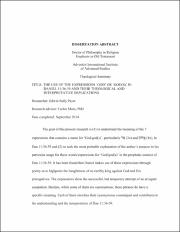| dc.description.abstract | The goal of this present research is (1) to understand the meaning of the 7
expressions that contains a name for ‘God/god(s)’, particularly 3) אֵל x) and 4) אֱלוֹהַּ x), in
Dan 11:36-39 and (2) to seek the most probable explanation of the author’s purpose in his
particular usage for these words/expressions for ‘God/god(s)’ in the prophetic context of
Dan 11:36-39. It has been found that Daniel makes use of these expressions through
poetry as to highpoint the haughtiness of an earthly king against God and His
prerogatives. The expressions show the successful, but temporary attempt of an arrogant
usurpation. Besides, while some of them are synonymous, these phrases do have a
specific meaning. Each of them enriches their synonymous counterpart and contributes to
the understanding and the interpretation of Dan 11:36-39.
Based on the word study אֵל is used to allude in many ANE nations to the
supreme god. In Dan 11:36, ‘the king’ will exalt and magnify himself over any supreme
god(s) that could be found. The superlative expression 11:36 ) אֵל אֵלִ ים ) as other
superlatives expressions for God in Daniel (cf. 2:47; 6:20, 26; 8:25; 9:4) refers to the true
God, as the ultimate supreme One over any other gods. הֵי # אֱ cannot be understood and
interpreted separated from the expression הֵי אֲבתָֹיו # אֱ, which the OT utilizes to mean
Yahweh, the God of covenant of Israel.
אֱלוֹ הּ relates in the OT God metaphorically to the notion of strength and/or of
protection, with a few times to the notion of salvation. It is associated twice in the OT
with צוּר , “rock,” which is another metaphor for God as place of refuge. In using אֱלוֹהַּ
intentionally to refer to a false god, Daniel refers indirectly to the true God, as a way to
point out to the idea of usurpation, or at least of replacement of God’s prerogatives in the
king’s character and leadership.
Two expressions referring to God were found— 11:36 ) אֵל אֵלִים ); and הֵי אֲבתָֹיו # אֱ
(11:37). In prophetical passages, Daniel never uses the most common names for God
אֲדנָֹי ,יהוה) , or הִים # אֱ), or god(s) ( הִים # אֱ). In writing Dan 11:36-39 Daniel deliberately
selects his vocabulary (1) by choosing to use names of God that are most of the time used
in poetry, and (2) to also highlight the main theme of the book of Daniel: the sovereignty
of God over all things ( אֵל ), who does not forget His people (and not only Israel, but also
the ‘spiritual Israel’ of all nations). He will come and rescue them ( אֱלוֹהַּ ; cf. 12:1-3). As
for the presence of the phrase הֵי אֲבתָֹיו # אֱ, which relates to the covenant and true God, it
is used to replace the common name for God, .יהוה
In using these 7 words/expressions for ‘God/god(s)’ in Dan 11:36-39, the prophet
wants to insist on the distinctly negative religious character of ‘the king’. To insist the
unbelievably awful personage of ‘the king’, the seer employs poetry. Daniel chooses to
not be succinct in his exposition. Such haughtiness is too important to just be simply
mentioned. Besides, it should be detailed enough as to underscore the reason why God
would finally come to judge the earth and to bring retribution against ‘the king’. The use
of poetic features (i.e., parallelisms, word pairs) permits the prophet to repeat his ideas in
a condensed manner. | en_US |

